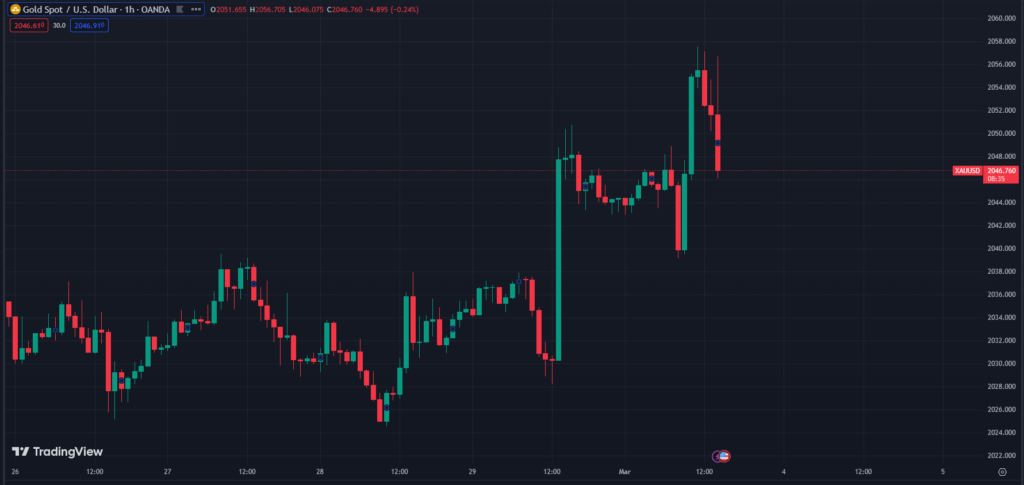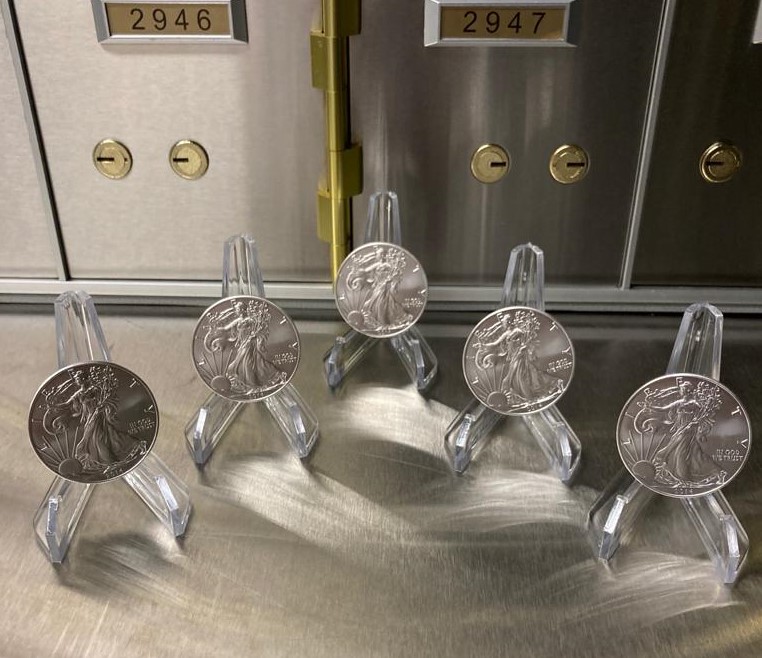
01/03/2024: This Week in Gold With Market Updates
Price Action:
Gold:
Gold opened the week trading at $2,035 an ounce after closing the previous week 1.1% higher. Gold made a move to the upside this week, searching for a second consecutive weekly rise. Price did initially move lower at the start of the week, closing the day in the red on Monday and Tuesday. However, gains on Thursday and Friday reversed these losses and saw gold’s momentum shift.
On Monday, price consolidated for much of the day and ultimately fell $4 to close the day 0.2% lower at $2,031. There was little news that could affect markets on Monday, with investors waiting for important inflation data which was to be released on Thursday.
On Tuesday, price held steady initially as investors were closely monitoring upcoming inflation forecasts and remarks from FED officials. Gold remained mainly unchanged, with the price falling $1 to $2,030 an ounce to close the day. The DXY remained constrained, which is good for gold buyers from overseas as it makes bullion cheaper, relatively speaking. Consumer confidence came in weaker than forecasted, which sparked an initial reaction from gold. However, these gains were reversed towards the end of the trading day.
On Wednesday, price began the day by moving lower. GDP (QoQ) data for Q4 was released at around midday. This caused the price of gold to reverse course and embark on a move to the upside. Price ultimately rose to $2,034 an ounce, closing the trading day 0.2% higher.
On Thursday, there was a welcome relief for gold bulls as the precious metal scaled a one-month high. Gold surged 0.9% to $2,048 an ounce upon the release of U.S. PCE data. Data aligned with market expectations and this weakened the dollar. A weakening dollar boosted gold’s appeal for investors holding other currencies. Anything that even hints at the possibility of lower interest rates is positive for the price of gold.
On Friday, price continued to push higher. At the time of writing, gold is trading at $2,048 an ounce, meaning that it is 0.6% up for the week and on track to close higher for the second consecutive week.

Silver:
Silver opened the trading week at $22.95 and closed Monday 1.9% lower at $22.52. The day’s session witnessed early weakness in silver prices, reflecting subdued investor sentiment. Despite an initial dip, silver managed to find some support towards the end of the trading day, preventing a further decline in prices.
On Tuesday, silver displayed sideways movement, opening at $22.52 and closing marginally lower at $22.46. The market exhibited signs of indecision. Silver struggled to gain momentum amidst a lack of clear catalysts, leading to a forgettable trading session characterised by consolidation.
On Wednesday, silver opened and closed at $22.46. The day’s trading session witnessed minimal price fluctuations, as silver remained range-bound within a narrow band. Market participants adopted a cautious approach, awaiting fresh developments to provide direction to the market.
On Thursday, there was a notable turnaround for silver, as prices surged from an opening of $22.46 to a closing level of $22.67. Silver benefited from U.S. PCE data, similarly to gold.
As of the current trading session on Friday, silver prices opened at $22.67 and continue to show signs of strength. At the time of writing, silver is trading at $22.59, which is a 1.6% decline for the week.

Market Updates:
Tuesday 27th February: U.S. Consumer Confidence:
U.S. Consumer Confidence data on Tuesday came in at 106.7, below the forecasted 114.8 and lower than the previous month’s reading of 110.9. This unexpected decline in consumer confidence signals potential headwinds for the U.S. economy, reflecting concerns over rising inflationary pressures and geopolitical uncertainties. The subdued consumer sentiment could dampen consumer spending, impacting overall economic growth prospects. Investors are likely to monitor this data closely for its implications on monetary policy decisions by the Federal Reserve and its potential effects on asset prices, including gold.
Wednesday 28th February: GDP (QoQ) (Q4):
Wednesday’s release of Quarter 4 GDP data for the U.S. unveiled a growth rate of 3.2%, slightly below the forecasted 3.3% and lower than the previous quarter’s robust 4.9% expansion. While the economy continues to show resilience, the moderation in GDP growth suggests a potential slowdown in economic momentum. Factors such as supply chain disruptions and ongoing global uncertainties may have contributed to the moderation in growth. Investors are likely to look to this data for insights into the health of the U.S. economy and its potential impact on investment decisions, including allocations to safe-haven assets like gold.
Thursday 29th February: U.S. Personal Consumption Expenditure:
U.S. Personal Consumption Expenditure came in at 2.8%, in line with analyst forecasts. The Federal Reserve closely monitors consumer spending as a key determinant of inflationary trends and may adjust monetary policy accordingly. The data could influence investor sentiment towards gold, as a non-accelerated figure may indicate that the FED may begin to cut rates soon. This would boost demand for gold, as the opportunity cost of holding the metal decreases as rates get cut.
Thursday 29th February: Jobless Claims:
Thursday’s Jobless Claims data showed a slight uptick, with the actual figure coming in at 215,000, higher than the forecasted 209,000 but still below the previous month’s reading of 202,000. While the labour market remains resilient, the increase in jobless claims may signal challenges in the employment landscape. Investors monitor labour market dynamics closely for their implications on consumer spending, inflation, and overall economic growth, which could impact gold prices.
Friday 1st March: Eurozone Consumer Price Index:
Friday’s release of the Eurozone Consumer Price Index (CPI) showed a higher-than-expected inflation rate of 3.1%, surpassing the forecasted 2.9% but lower than the previous month’s reading of 3.3%. The European Central Bank (ECB) closely monitors inflation dynamics as it formulates monetary policy decisions, including the Central Bank’s stance on interest rates down the line. With an increase in inflation, it is unlikely that the bank will cut rates soon, which would ultimately dampen the demand for gold as interest-bearing assets remain more favourable.
